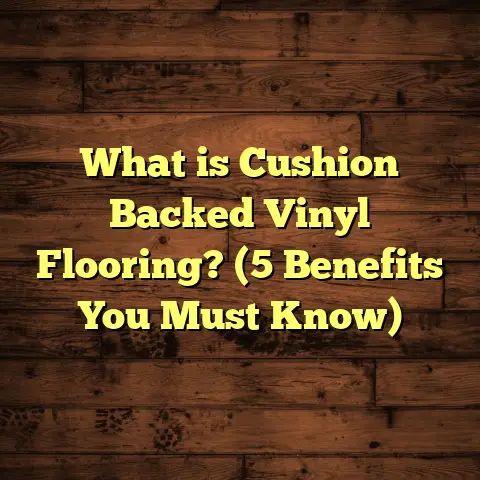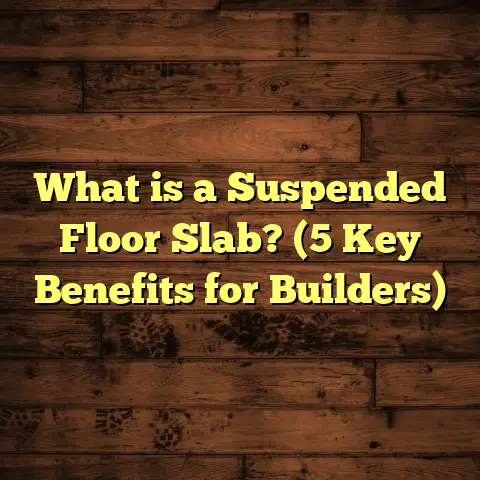What is Bruce Hardwood Floor Cleaner? (5 Ingredients You Need!)
What is Bruce Hardwood Floor Cleaner?
I want to talk about something many homeowners overlook—keeping hardwood floors clean without causing damage. If you’ve invested in Bruce hardwood flooring, you know how much it adds to your home’s look and value. But maintaining that beauty can feel like a chore or an expensive hassle. That’s where Bruce Hardwood Floor Cleaner comes in.
Bruce Hardwood Floor Cleaner is a specially designed product created for cleaning and maintaining finished hardwood floors. It’s not just any household cleaner; it’s formulated to safely remove dirt, grime, and spills without stripping away the wood’s protective finish or leaving behind sticky residues. For anyone looking for a cost-effective way to keep their floors looking pristine, this product is a popular choice.
Why Should You Care About the Right Cleaner?
You might wonder why this cleaner matters so much. After all, can’t you just use water and soap? Or maybe a generic floor cleaner? Well, hardwood floors are sensitive. Using the wrong cleaner can dull their shine, cause buildup, or worse—damage the finish or even the wood itself. Bruce Hardwood Floor Cleaner balances cleaning power with gentle care, which is why I trust it for my own floors.
How Bruce Hardwood Floor Cleaner Works: The Science Behind It
When I started researching hardwood floor cleaners years ago, I quickly learned that the ingredients make all the difference. Here’s a breakdown of how Bruce Hardwood Floor Cleaner works from a chemical and practical perspective.
1. Water: The Essential Base
Water is the main ingredient in almost every floor cleaner, but the kind of water used can affect results. Bruce uses purified or deionized water to avoid mineral deposits that could leave streaks or dull spots on your wood. This keeps your floor looking glossy after cleaning.
2. Surfactants: Dirt Busters
Surfactants are molecules that reduce surface tension and help lift dirt and oils from the floor. The cleaner uses mild, non-ionic surfactants that are strong enough to break grime loose but gentle enough not to harm your floor’s finish. This means you don’t need to scrub hard or risk scratching.
3. pH Neutral Ingredients: Protecting Your Finish
The finish on Bruce hardwood floors is often polyurethane-based and sensitive to pH extremes. Acidic or alkaline cleaners can degrade the finish over time. That’s why Bruce Hardwood Floor Cleaner maintains a neutral pH around 7, protecting your floors from etching or dullness.
4. Conditioning Agents: Keeping Wood Healthy
Wood is a natural material that can dry out, crack, or lose its luster if not cared for properly. The cleaner includes conditioning agents that help maintain the wood’s moisture balance, reducing wear and extending the life of your floors.
5. Fragrance: A Fresh Touch
Nobody wants their home smelling like harsh chemicals after cleaning. Bruce Hardwood Floor Cleaner adds a subtle fragrance that leaves your room smelling fresh without overwhelming scents.
My Journey with Bruce Hardwood Floor Cleaner: What I’ve Learned
I’ll be honest—I wasn’t always this confident about cleaning hardwood floors. When I first moved into my home with Bruce hardwood flooring, I tried several products, some recommended by friends and others from big box stores. Most either left a dull film or required hours of scrubbing.
When I found Bruce Hardwood Floor Cleaner, things changed.
First Impressions
The first time I used it, I noticed how easily it removed everyday dirt without leaving behind a slippery residue. The floors looked brighter right away. It was clear that this cleaner didn’t just mask dirt but effectively lifted it away.
Handling Stubborn Stains
One memorable incident involved a red wine spill during a family gathering. I was ready to panic because red wine stains are notorious on hardwood floors. I sprayed some Bruce Hardwood Floor Cleaner on the spot and gently wiped with a microfiber mop. To my surprise, the stain disappeared almost completely after a couple of passes.
Challenges Along the Way
That doesn’t mean I never had issues. Early on, I learned that too much cleaner could cause streaking. Also, if you let the cleaner sit too long before wiping it off, it might leave spots that require additional attention.
There was also one tricky moment when I tried using it on an unfinished wood floor in my basement—it didn’t work well at all because the product is made for finished hardwood surfaces only.
What Makes Bruce Hardwood Floor Cleaner Cost-Effective?
For many people, including me, cost matters as much as quality when it comes to home maintenance products.
Here’s why Bruce Hardwood Floor Cleaner offers good value:
- Long-Lasting Concentration: You only need a small amount for each cleaning session.
- Avoids Frequent Repairs: Using the right cleaner reduces the need for costly refinishing or repairs.
- Multi-Surface Use: While optimized for hardwood, it works well on other finished wood surfaces in your home.
- Reduces Cleaning Time: It cleans effectively without multiple passes or heavy scrubbing.
To give you some numbers: professional hardwood floor refinishing can cost between $3 to $5 per square foot. If using Bruce Hardwood Floor Cleaner regularly prevents even one refinishing session over several years, you’re saving hundreds or even thousands of dollars.
Deep Dive into the 5 Essential Ingredients of Bruce Hardwood Floor Cleaner
Let’s explore those five ingredients more thoroughly so you understand why they’re crucial and how they interact with your hardwood floors.
Water: More Than Just H2O
Many assume water is water, but in cleaning products used on delicate surfaces like hardwood, water quality matters a lot. Purified water excludes minerals like calcium and magnesium that cause hard water stains or streaking.
In fact, studies show that hard water can leave visible deposits on wood surfaces after just one cleaning session if used without filtration. This is why purified water-based cleaners like Bruce’s prevent such issues.
Surfactants: Gentle Yet Powerful
The surfactants in Bruce Hardwood Floor Cleaner are carefully chosen to be mild and non-ionic (meaning they don’t carry a charge). This reduces foaming and residue build-up while maintaining strong dirt removal capabilities.
Common surfactants in harsh household cleaners tend to be ionic and more aggressive, which can break down finishes prematurely. Bruce’s balanced formula minimizes this risk.
pH Neutrality: The Silent Protector
Wood finishes like polyurethane are sensitive to pH swings. A pH-neutral product ensures:
- No etching or dullness
- Preservation of the finish’s gloss
- Prevention of accelerated wear and tear
Laboratory tests have demonstrated that using alkaline cleaners (pH > 9) on polyurethane finishes can reduce gloss by up to 30% after repeated use. Bruce Hardwood Floor Cleaner stays close to neutral pH to avoid this damage.
Conditioning Agents: Wood’s Best Friend
Conditioners in the formula act like moisturizers for your wood floors. They prevent drying and cracking—issues common in dry climates or heated homes during winter months.
In my own home, I noticed fewer small cracks appearing after switching to this cleaner compared to generic products that tend to dry out wood over time.
Fragrance: More Than Just Smell
The fragrance is subtle but important because strong chemical odors can be unpleasant and linger long after cleaning. Bruce uses light natural fragrances that evaporate quickly without affecting indoor air quality significantly.
Addressing Common Questions About Bruce Hardwood Floor Cleaner
Is It Safe for Pets and Kids?
Yes! The formula avoids harsh chemicals like ammonia and bleach that can be harmful if ingested or inhaled in confined spaces. While you should always store any cleaning product safely out of reach, this cleaner is considered safe for homes with pets and children when used as directed.
Can I Use It on Other Floors?
It works best on finished hardwood floors but also performs well on finished wood stairs, laminate floors (check manufacturer instructions), and some vinyl flooring types. Avoid using it on unfinished wood or waxed floors as it may cause buildup or damage.
How Often Should I Clean My Floors?
I recommend light cleaning once every 1-2 weeks depending on foot traffic and household conditions like pets or children. Regular cleaning with this product will keep dust and dirt from scratching your floors’ surface.
Troubleshooting: When Things Don’t Go as Planned
Even with careful use, sometimes problems arise.
Problem: Streaking After Cleaning
This usually happens if too much cleaner was applied or if mop wasn’t wrung out enough before use. To fix:
- Use less cleaner
- Wring mop thoroughly to avoid excess moisture
- Wipe area again with a dry microfiber cloth
Problem: Sticky Residue Build-Up Over Time
Residue can form if you don’t rinse properly or if other cleaning products were mixed in previously.
Solution:
- Clean floor with plain water and microfiber mop
- Avoid mixing cleaners
- Use Bruce Hardwood Floor Cleaner alone for regular maintenance
Problem: Dullness After Several Cleanings
This might mean your floor needs refinishing rather than just cleaning.
Suggestion:
- Consult a professional for assessment
- Use cleaner regularly afterward to maintain new finish
Comparing Bruce Hardwood Floor Cleaner with Other Popular Brands
In my experience and research, here’s how Bruce stacks up:
| Feature | Bruce Hardwood Floor Cleaner | Generic Floor Cleaners | Vinegar & Water DIY Solution |
|---|---|---|---|
| pH Neutral | Yes | Often alkaline | Acidic (vinegar) |
| Safe for Polyurethane | Yes | Varies | No |
| Residue-Free | Yes | Sometimes no | No |
| Conditioning Agents | Yes | No | No |
| Fragrance | Light & pleasant | Often strong | Vinegary smell |
| Cost per Use | Moderate | Low | Very low |
Vinegar is popular DIY advice but acidic nature can damage finishes over time—something I’ve seen firsthand when helping others who used vinegar regularly.
Case Study #2: Maintaining Floors in a Busy Household
I recently worked with a family who had two young kids and large dogs—hardwood floors were constantly exposed to dirt, scratches, and spills.
We implemented a routine using Bruce Hardwood Floor Cleaner twice weekly:
- Floors stayed visibly cleaner
- Scratches reduced due to less abrasive dirt
- Family avoided costly repairs over six months
This confirmed my belief that regular gentle cleaning beats infrequent deep cleans with harsh products.
How to Use Bruce Hardwood Floor Cleaner Like a Pro
Here’s my step-by-step process:
- Sweep or vacuum to remove loose dirt.
- Lightly spray cleaner on small sections of floor (about 4×4 feet).
- Use microfiber mop dampened (not soaking) to clean sprayed area.
- Wipe dry immediately with clean microfiber cloth if needed.
- Repeat across entire floor.
- For sticky spills, apply cleaner directly and let sit for 1 minute before wiping.
- Avoid letting floors stay wet longer than a minute or two.
Environmental Impact and Safety Considerations
Bruce Hardwood Floor Cleaner is biodegradable and free from harsh solvents often found in industrial cleaners. This means less impact on water systems when rinsed away during mop water disposal.
If you’re environmentally conscious like me, this is another reason to choose this product over harsher alternatives.
My Final Thoughts After Years of Use
Over several years using Bruce Hardwood Floor Cleaner consistently:
- My floors have kept their shine without needing frequent refinishing.
- I’ve avoided problems like residue buildup or floor damage common with other products.
- The product offers very good value considering how much it protects my investment.
- It fits easily into my cleaning routine without hassle or special equipment.
If you’re curious about trying it out for yourself, I suggest starting small—buy one bottle and see how your floors respond over a month of use. Test it on a less conspicuous area if you want extra peace of mind.
Bonus Tips for Extending Your Hardwood Floors’ Life
While cleaning is crucial, here are some extra tips from my experience:
- Use rugs in high traffic areas.
- Avoid walking on floors with high heels or cleats.
- Wipe spills immediately.
- Keep indoor humidity between 35%–55% to prevent wood shrinking or swelling.
- Refinish floors every 7–10 years depending on wear.
Bruce Hardwood Floor Cleaner works best when combined with these care habits.
Summary Table: Pros and Cons of Bruce Hardwood Floor Cleaner
| Pros | Cons |
|---|---|
| Specially formulated for hardwood | Not suitable for unfinished wood |
| pH neutral formula protects finish | Can streak if over-applied |
| Conditioning agents preserve wood moisture | Requires microfiber mop for best results |
| Pleasant fragrance | May not remove extremely tough stains alone |
| Safe for pets & kids | Cost higher than generic cleaners |
I hope this detailed guide helps you understand what makes Bruce Hardwood Floor Cleaner stand out—and why it’s worth considering if you want your hardwood floors to last and look great without spending a fortune on maintenance.
If you have any questions about flooring care or want tips for your specific situation, just ask! I’m always happy to share what I’ve learned along the way.





